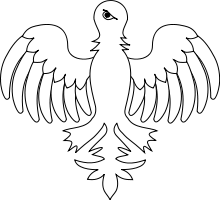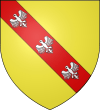Avalerion

An avalerion or alerion is a mythological bird. It was "rather small, yet larger than an eagle" and lived near the Hydaspes and the Indus according to European medieval geographers and bestiaries, which were possibly based on a description by Pliny. Only two of the birds were said to exist at a time. A pair of eggs was laid every 60 years; after hatching, the parents drowned themselves.[1]
Some coats of arms include alerions. In heraldry, an alerion is most often depicted as a bird with no beak and feathered stumps in place of legs, or no legs at all. Notably, the coat of arms of Lorraine features three alerions, because alerion is a partial anagram of Lorraine.
The word's ultimate origin is unclear, possibly adapted from the German Adler (‘eagle’) or Adelar (‘noble eagle’). And it is found in 12th-century French as alérion and in medieval Latin as alariōnem (a large eagle-like bird).[2]
See also
Notes
- ↑ Bevan & Phillott, pp. 30–31
- ↑ "alerion". Oxford English Dictionary (3rd ed.). Oxford University Press. September 2005. (Subscription or UK public library membership required.)
References
| Wikimedia Commons has media related to Alerions in heraldry. |
- William Latham Bevan; Henry Wright Phillott (1873). Mediæval Geography: An Essay in Illustration of the Hereford Mappa Mundi. London: E. Stanford. pp. 30–31.
- Guillaume de Machaut (1994). The Tale of the Alerion. Translated by Minnette Gaudet and Constance B. Hieatt. Toronto: University of Toronto Press.
